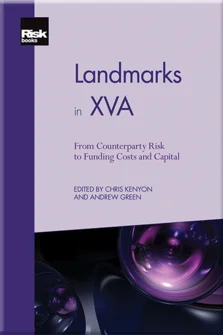Bounding Wrong-Way Risk in Measuring Counterparty Risk
Paul Glasserman and Linan Yang
Introduction
Preface to Chapter 1
Being Two-Faced over Counterparty Credit Risk
Risky Funding: A Unified Framework for Counterparty and Liquidity Charges
DVA for Assets
Pricing CDSs’ Capital Relief
The FVA Debate
The FVA Debate: Reloaded
Regulatory Costs Break Risk Neutrality
Risk Neutrality Stays
Regulatory Costs Remain
Funding beyond Discounting: Collateral Agreements and Derivatives Pricing
Cooking with Collateral
Options for Collateral Options
Partial Differential Equation Representations of Derivatives with Bilateral Counterparty Risk and Funding Costs
In the Balance
Funding Strategies, Funding Costs
The Funding Invariance Principle
Regulatory-Optimal Funding
Close-Out Convention Tensions
Funding, Collateral and Hedging: Arbitrage-Free Pricing with Credit, Collateral and Funding Costs
Bilateral Counterparty Risk with Application to Credit Default Swaps
KVA: Capital Valuation Adjustment by Replication
From FVA to KVA: Including Cost of Capital in Derivatives Pricing
Warehousing Credit Risk: Pricing, Capital and Tax
MVA by Replication and Regression
Smoking Adjoints: Fast Evaluation of Monte Carlo Greeks
Adjoint Greeks Made Easy
Bounding Wrong-Way Risk in Measuring Counterparty Risk
Wrong-Way Risk the Right Way: Accounting for Joint Defaults in CVA
Backward Induction for Future Values
A Non-Linear PDE for XVA by Forward Monte Carlo
Efficient XVA Management: Pricing, Hedging and Allocation
Accounting for KVA under IFRS 13
FVA Accounting, Risk Management and Collateral Trading
Derivatives Funding, Netting and Accounting
Managing XVA in the Ring-Fenced Bank
XVA: A Banking Supervisory Perspective
An Annotated Bibliography of XVA
The study of counterparty risk has become increasingly important since the failures of major derivatives dealers Bear Stearns, Lehman Brothers and AIG Financial Products in 2008. Basel III includes a new capital charge for counterparty risk, which is among the largest changes to capital requirements for banks with major derivatives businesses (Basel Committee on Banking Supervision 2010). Proper measurement of counterparty risk is essential to financial stability, yet it presents significant modelling and computational challenges for industry participants.
Counterparty risk combines market exposure and credit risk. Market factors determine the size of a firm’s exposure to a counterparty, and credit risk determines the likelihood that the counterparty will default, turning the exposure into a loss. The proper integration of these two sources of uncertainty is one of the major challenges in counterparty risk measurement.
Wrong-way risk refers to the possibility that the two sources of risk move together, so that the market exposure increases just as the counterparty’s risk of default increases. Wrong-way risk arises, for example, if one bank sells credit default swap protection
Copyright Infopro Digital Limited. All rights reserved.
As outlined in our terms and conditions, https://www.infopro-digital.com/terms-and-conditions/subscriptions/ (point 2.4), printing is limited to a single copy.
If you would like to purchase additional rights please email info@risk.net
Copyright Infopro Digital Limited. All rights reserved.
You may share this content using our article tools. As outlined in our terms and conditions, https://www.infopro-digital.com/terms-and-conditions/subscriptions/ (clause 2.4), an Authorised User may only make one copy of the materials for their own personal use. You must also comply with the restrictions in clause 2.5.
If you would like to purchase additional rights please email info@risk.net











